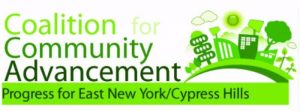
The ANHD Blog raises the profile of our issues, and educates our member groups, city decision makers, and the general public on our core issue areas. The ANHD Blog offers sharp, timely and effective commentary on key public policy issues, as well as our work and the work of our member groups.
All of our blogs are sorted based on the issues, projects, special tags, and dates they are associated with, and you can use the dropdowns below to filter through our blogs based on these tags. Additionally, you can do a general search through our blog, using the search bar the right. If you can’t find what you are looking for, email comms@anhd.org.
East New York Coalition Calls for Community Benefits or No Development
As the first neighborhood rezoning under the de Blasio Administration, the Coalition for Community Advancement: Progress for East New York has presented communities with a first look at how to approach the City on issues of displacement, affordability, and development.
As the first neighborhood rezoning under the de Blasio Administration, the Coalition for Community Advancement: Progress for East New York has presented communities with a first look at how to approach the City on issues of displacement, affordability, and development.
Tomorrow, their efforts will focus on ensuring community benefits are intrinsically part of new neighborhood developments. Specifically, the Coalition is demanding robust local hire, use of local suppliers, inclusion of community facilities, discounted commercial space for local retailers/services, reinvestment of the developer’s fees into East New York, and meaningful involvement of local nonprofits. To achieve these goals, they are calling on the NYC Economic Development Corporation (NYCEDC) to require applicants to address these issues in the current Office Anchor Strategy request for proposals (RFP). Because of the need for a robust plan to address crucial community benefits, the Coalition is calling on NYCEDC to postpone the current deadline (August 18) by four months.
The efforts underway in East New York are an instructional moment for communities in the midst of-or anticipating-a rezoning. The conversation around the need for local jobs, training, and affordable space may begin around a single rezoning. However, the Coalition demonstrates that in those efforts, the fight for a community’s future is not wholly dependent to a particular land use process; it is dependent on the vigilance of neighborhood advocates to push for tangible and equitable development where ever it may occur.


